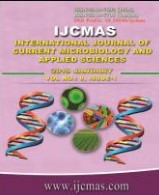


 National Academy of Agricultural Sciences (NAAS)
National Academy of Agricultural Sciences (NAAS)

|
PRINT ISSN : 2319-7692
Online ISSN : 2319-7706 Issues : 12 per year Publisher : Excellent Publishers Email : editorijcmas@gmail.com / submit@ijcmas.com Editor-in-chief: Dr.M.Prakash Index Copernicus ICV 2018: 95.39 NAAS RATING 2020: 5.38 |
The present investigation was conducted on records of 2959 buffaloes, progeny of 219 sires over a period of 24 years(1992-2015) maintained at Buffalo research centre(BRC), LUVAS, Hisar and Animal farm ICAR-CIRB, Hisar, Four sire evaluation procedures such as ordinary least squares (OLS), regressed least squares (RLS), Derivative free restricted estimated maximum likelihood (DFREML) and best linear unbiased prediction (BLUP) based on estimated breeding value of performance traits such as first lactation milk yield (FLY), first lactation peak yield (FPY), first lactation milk yield per day of first lactation length (MLL = FLY/FLL); first lactation milk yield per day of first calving interval (MCI = FLY/FCI) and first lactation milk yield per day of age at second calving (MSC = FLY/AFC+FCI) were compared. The results indicated that sire number 63 had the highest merit computed by OLS, RLS and sire number 27 had the highest merit for MCI computed by either of the four methods. In addition, sire number 63 had the highest merit for MSC computed by all the methods except OLS where it stood fourth in ranking. Product-moment correlations were comparatively lower than those of rank correlations barring a few exceptions. When comparison was made on the basis of coefficient of skewness, OLS was found superior for estimation of breeding value for FLY, MLL and MSC whereas RLS for FPY and BLUP for MCI. When comparison was made on the basis of coefficient of kurtosis, DFREML was better for FLY and FPY; OLS for MCI; and BLUP for MLL and MSC whereas RLS was found inferior when comparison was made on the basis of coefficient of kurtosis. When standard error of the estimate was considered, RLS was found to be more accurate in case of FLY, MLL, MCI and MLL. It is recommended to use BLUP where correct ratio of residual variance to sire variances is known.
 |
 |
 |
 |
 |